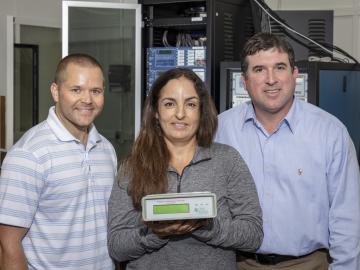
Filter News
Area of Research
- (-) Energy Science (75)
- (-) National Security (10)
- Advanced Manufacturing (5)
- Biology and Environment (39)
- Computer Science (3)
- Electricity and Smart Grid (3)
- Functional Materials for Energy (1)
- Fusion and Fission (10)
- Fusion Energy (2)
- Isotope Development and Production (1)
- Isotopes (2)
- Materials (101)
- Materials Characterization (1)
- Materials for Computing (17)
- Materials Under Extremes (1)
- Neutron Science (23)
- Nuclear Science and Technology (3)
- Quantum information Science (3)
- Sensors and Controls (1)
- Supercomputing (40)
- Transportation Systems (1)
News Topics
- (-) Grid (43)
- (-) Materials Science (29)
- (-) Mercury (3)
- (-) Microscopy (8)
- (-) Simulation (4)
- 3-D Printing/Advanced Manufacturing (81)
- Advanced Reactors (7)
- Artificial Intelligence (19)
- Big Data (11)
- Bioenergy (28)
- Biology (14)
- Biomedical (7)
- Biotechnology (5)
- Buildings (38)
- Chemical Sciences (14)
- Clean Water (8)
- Composites (17)
- Computer Science (41)
- Coronavirus (14)
- Critical Materials (9)
- Cybersecurity (25)
- Energy Storage (71)
- Environment (59)
- Exascale Computing (2)
- Fossil Energy (2)
- Frontier (2)
- Fusion (2)
- High-Performance Computing (10)
- Hydropower (3)
- Isotopes (1)
- Machine Learning (18)
- Materials (36)
- Mathematics (2)
- Microelectronics (1)
- Molten Salt (1)
- Nanotechnology (9)
- National Security (37)
- Neutron Science (15)
- Nuclear Energy (11)
- Partnerships (16)
- Physics (2)
- Polymers (11)
- Quantum Science (3)
- Security (15)
- Space Exploration (3)
- Statistics (1)
- Summit (6)
- Transportation (68)
Media Contacts

A team of researchers at Oak Ridge National Laboratory have demonstrated that designed synthetic polymers can serve as a high-performance binding material for next-generation lithium-ion batteries.

Sometimes solutions to the biggest problems can be found in the smallest details. The work of biochemist Alex Johs at Oak Ridge National Laboratory bears this out, as he focuses on understanding protein structures and molecular interactions to resolve complex global problems like the spread of mercury pollution in waterways and the food supply.

Scientists at Oak Ridge National Laboratory have developed a low-cost, printed, flexible sensor that can wrap around power cables to precisely monitor electrical loads from household appliances to support grid operations.

Gleaning valuable data from social platforms such as Twitter—particularly to map out critical location information during emergencies— has become more effective and efficient thanks to Oak Ridge National Laboratory.

Oak Ridge National Laboratory scientists studying fuel cells as a potential alternative to internal combustion engines used sophisticated electron microscopy to investigate the benefits of replacing high-cost platinum with a lower cost, carbon-nitrogen-manganese-based catalyst.

As Puerto Rico works to restore and modernize its power grid after last year’s devastating hurricane season, researchers at Oak Ridge National Laboratory have stepped up to provide unique analysis, sensing and modeling tools to better inform decisions.

Oak Ridge National Laboratory scientists have devised a method to control the heating and cooling systems of a large network of buildings for power grid stability—all while ensuring the comfort of occupants.

Biologists from Oak Ridge National Laboratory and the Smithsonian Environmental Research Center have confirmed that microorganisms called methanogens can transform mercury into the neurotoxin methylmercury with varying efficiency across species.

Oak Ridge National Laboratory scientists have developed a crucial component for a new kind of low-cost stationary battery system utilizing common materials and designed for grid-scale electricity storage. Large, economical electricity storage systems can benefit the nation’s grid ...

A novel method developed at Oak Ridge National Laboratory creates supertough renewable plastic with improved manufacturability. Working with polylactic acid, a biobased plastic often used in packaging, textiles, biomedical implants and 3D printing, the research team added tiny amo...


